History
Guadix and Baza are two Andalusian towns in the Province of Granada, neighbors, sisters and rivals. Cascamorras, a worker from Guadix, found a buried sacred image of the Virgen de la Piedad (Our Lady of Mercy) while working on the land of Baza. Encouraged by his Guadixan countrymen, he attempted to carry the sacred image to Guadix, but Bazans snatched it before he arrived, punishing what they considered a sacred theft. When Cascamorras returned to Guadix empty-handed, his countrymen, who expected the image of the Virgin, were deeply disappointed and viciously pursued those they considered responsible for their frustration. Finally, hero and people reconciled, they prayed to the Virgin who was in the other town. Since then, recalling those events that unite and oppose them, Baza and Guadix celebrate the Fiesta de Cascamorras for three days in the late summer of each year.

Granada is a province of southern Spain, in the eastern part of the autonomous community of Andalusia. It is bordered by the provinces of Albacete, Murcia, Almería, Jaén, Córdoba, Málaga, and the Mediterranean Sea. Its capital city is also called Granada.

Celanova is a municipality in the province of Ourense, in the autonomous community of Galicia, Spain. It belongs to the comarca of Terra de Celanova. Situated near the border with Portugal, the municipality is bordered by Ramirás, Cartelle, A Merca, A Bola, Verea and Quintela de Leirado.
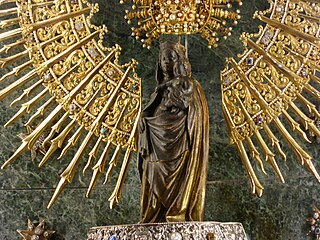
Our Lady of the Pillar is the name given to the Blessed Virgin Mary in the context of the traditional belief that Mary, while living in Jerusalem, supernaturally appeared to the Apostle James the Greater in AD 40 while he was preaching in what is now Spain. Those who adhere to this belief consider this appearance to be the only recorded instance of Mary exhibiting the mystical phenomenon of bilocation. Among Catholics, it is also considered the first Marian apparition, and unique because it happened while Mary was still living on Earth.

Moros y Cristianos or Moros i Cristians literally in English Moors and Christians, is a set of festival activities which are celebrated in many towns and cities of Spain, mainly in the southern Valencian Community. According to popular tradition the festivals commemorate the battles, combats and fights between Moors and Christians during the period known as Reconquista. There are also festivals of Moros y Cristianos in Spanish America.

Candelaria, also Villa Mariana de Candelaria, is a municipality and city in the eastern part of the island of Tenerife in the Province of Santa Cruz de Tenerife, in the Canary Islands, Spain. The city is located on the coast, 17 km southwest of Santa Cruz de Tenerife. The population is 25,140 (2010), and the area is 49.18 km².

Baza is a town in the province of Granada in Andalusia, twice a former Catholic bishopric and now a Latin Catholic titular see as Basti.

Montefrio is a municipality in the province of Granada. The ruins of a Moorish castle sit near the highest point. Being built midway between the Sierra de Priego and Sierra Parapanda, and commanding the open valley between these ranges, it became one of the chief frontier fortresses of the Moors in the 15th century.
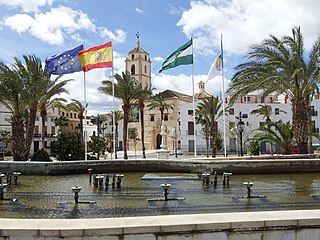
Albox is a Spanish municipality in the province of Almeria in the autonomous community of Andalusia. It is situated in the north eastern part of Valle del Almanzora and 120 km from the provincial capital, Almería. In the year 2017 it had 11,481 inhabitants. Its superficial area is 168.42 km2 and it has a population density of 68 inhabitants/km2.

The Basilica of Our Lady of Copacabana is a 17th-century Spanish colonial shrine that houses the image of the Virgen de Copacabana. It is located in the town of Copacabana, Bolivia on the shores of Lake Titicaca near the Altiplano region. Our Lady of Copacabana is the patron saint of Bolivia.

Our Lady of Solitude of Porta Vaga is a Roman Catholic Marian title of the Blessed Virgin Mary, based on the Marian apparitions reported in 1667 by a Spanish soldier during a night storm when he watched over the gates of Porta Vaga, later on the next day the icon was discovered in the seashore of Cañacao bay. The Virgin of Soledad is a venerated Marian icon associated to the Our Lady of Solitude. The province of Cavite and the city of Cavite consider her as its patroness.

The Autovía A-92 is a highway in Andalusia, Spain. It is a major east–west route running south of the Sierra Nevada and is known as the Carretera Sevilla a Granada and Autovía de Andalucía.

The Archdiocese of San Fernando is the archdiocese of the Latin Church of the Catholic Church in Pampanga, Philippines which has territorial jurisdiction over the whole province of Pampanga and Angeles City. The archdiocese is also the metropolitan see of the ecclesiastical province of the same name, which also include three dioceses of its surrounding provinces of Bataan, Zambales, and Tarlac. The cathedral church and seat of the archdiocese is the Metropolitan Cathedral of San Fernando (Pampanga). The Virgin Mary, under the title Virgen de los Remedios, is the principal patroness.
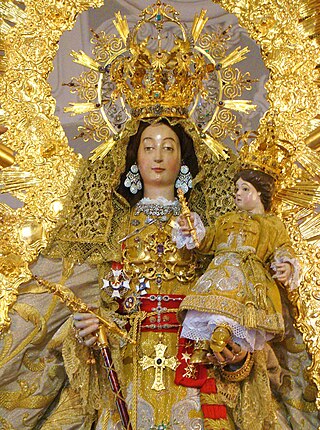
The Virgin of Los Remedios or Our Lady of Los Remedios is a title of the Virgin Mary developed by the Trinitarian Order, founded in the late 12th century. The devotion became tied to the Reconquista of Spain, then still at its height. In the following century it spread to other parts of Europe. When Spain began the exploration and conquest of the Americas, it was a favorite devotion of the Spanish conquistadores. It remains a popular devotion in Spain and Latin America.

The Virgin of Candelaria or Our Lady of Candle (Tagalog: Mahal na Birhen ng Candelaria, popularly called La Morenita, celebrates the Virgin Mary on the island of Tenerife, one of the Canary Islands. The center of worship is located in the city of Candelaria in Tenerife. She is depicted as a Black Madonna. The "Royal Basilica Marian Shrine of Our Lady of Candelaria" is considered the main church dedicated to the Virgin Mary in the Canary Islands and she is the patroness saint of the Canary Islands. Her feast is celebrated on February 2 and August 15, the patronal feast of the Canary Islands.
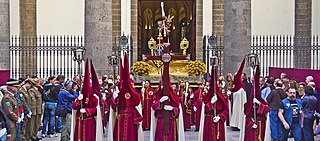
Holy Week in Spain is the annual tribute of the Passion of Jesus Christ celebrated by Catholic religious brotherhoods and fraternities that perform penance processions on the streets of almost every Spanish city and town during the Holy Week –the last week of Lent, immediately before Easter–.

The Virgin of Almudena is a medieval statue of the Virgin Mary, mother of Jesus Christ. The Virgin Mary is regarded as a patroness of Madrid, Spain, under this title.
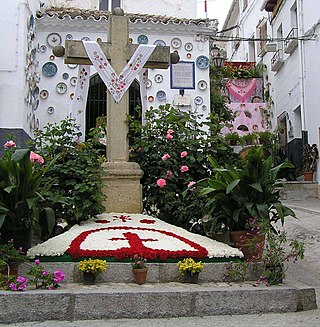
The Fiesta de las Cruces or Cruz de Mayo is a holiday celebrated on 3 May in many parts of Spain and Hispanic America.

Our Lady of Andacollo, also known as the Virgin of Andacollo, is a celebrated Catholic statue of the Virgin Mary located in the town of Andacollo, in the Coquimbo Region in the north of Chile. The carving is the centre of the annual Fiesta Grande de la Virgen that draws thousands of pilgrims from around the world in December.

La Herradura is a seaside resort on Spain's Costa Tropical, part of the borough of Almuñécar, in the province of Granada, Andalucía. It is on Granada's south-western coast, 70 kilometres east of Málaga.

The current configuration of the province of Granada is the result of a long process of territorial organization that reached its culmination in 1833, by means of the decree of provincialization promulgated by Javier de Burgos, Ministry of Development of the government of the regent Maria Christina of Bourbon. Until that date, what now constitutes the province of Granada was integrated within the limits of the so-called Kingdom of Granada.





















